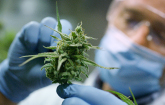
Findings published in the Association for Diagnostics & Laboratory Medicine's (formerly AACC's) Clinical Chemistry journal
WASHINGTON, Nov. 12, 2025 /PRNewswire/ -- A new study demonstrates that many regular marijuana users exceed legal blood cannabis limits for U.S. drivers despite showing no evidence of impairment. The findings, published today in the Association for Diagnostics & Laboratory Medicine's (formerly AACC's) Clinical Chemistry journal, contribute to evidence that cannabis blood limit laws lack scientific credibility and are not an accurate determinant of when drivers should face criminal charges or not.
View the full study here: https://doi.org/10.1093/clinchem/hvaf121
Previous research that evaluated the effect of delta-9-tetrahydrocannabinol (THC, the main psychoactive compound in cannabis) on motor vehicle crashes concluded that there is no increase of crash risk because of detectable THC. Despite evidence showing no correlation between the detection of THC in the blood and driving impairment, 6 states in the United States have per se laws using 2 or 5 ng/mL of THC as the cut-off point for driving under the influence of cannabis, while 12 have a zero-tolerance law. These cut-off points are considered face value evidence of driving impairment, which means that even if it has been several days since an individual's last use of the drug and they show no behavioral impairment, they may still face legal risks, up to and including felony charges.
To address this issue, a team of researchers led by Dr. Thomas D. Marcotte, professor of psychiatry at the University of California, San Diego, and codirector of the Center for Medicinal Cannabis Research, set out to investigate the blood concentrations of THC in regular cannabis users, as well as the simulated driving performance for participants who exceeded per se cut-off points compared with those who were below these values. The researchers measured baseline concentrations of THC in 190 regular cannabis users after instructing participants to abstain from cannabis for at least 48 hours. Following abstention, the researchers also evaluated driving performance in this group using a driving simulator.
From this, the team found that many regular users of cannabis exceed zero tolerance and per se THC cut-off point concentrations days after their last use. Specifically, 43% of participants exceeded zero-tolerance statutes at baseline, while 24% had baseline blood THC concentrations that were greater than or equal to the per se cut-off of 2 ng/mL, and 5.3% had blood concentrations greater than or equal to 5 ng/mL. Based on the results from the driving simulation, participants with elevated baseline concentrations of THC did no worse on a driving simulator compared with participants who were below per se cut-off points. Altogether, the results add to a growing body of evidence showing that current per se THC blood limit laws lack scientific credibility as face-value evidence of impairment.
"More work needs to be done to address how to best identify drivers who are under the influence of cannabis and are unsafe to drive," the study authors wrote. "At present, the best protocol is a combination of observations in the field and toxicology testing." They also added that "an essential component of improving highway safety is collaborations between law enforcement and the scientific community to develop standards that are unbiased and potentially lifesaving."
About the Association for Diagnostics & Laboratory Medicine (ADLM)
Dedicated to achieving better health for all through laboratory medicine, ADLM (formerly AACC) unites more than 70,000 clinical laboratory professionals, physicians, research scientists, and business leaders from 110 countries around the world. Our community is at the forefront of laboratory medicine's diverse subdisciplines, including clinical chemistry, molecular diagnostics, mass spectrometry, clinical microbiology, and data science, and is comprised of individuals holding the spectrum of lab-related professional degrees, certifications, and credentials. Since 1948, ADLM has championed the advancement of laboratory medicine by fostering scientific collaboration, knowledge sharing, and the development of innovative solutions that enhance health outcomes. For more information, visit www.myadlm.org.
About Clinical Chemistry
Clinical Chemistry (clinchem.org) is the leading international journal of laboratory medicine, featuring nearly 400 peer-reviewed studies every year that help patients get accurate diagnoses and essential care. This vital research is advancing areas of healthcare ranging from genetic testing and drug monitoring to pediatrics and appropriate test utilization.
Christine DeLong
ADLM
Director, Editorial and Media Relations
(p) 202.835.8722
[email protected]
Bill Malone
ADLM
Senior Director, Strategic Communications
(p) 202.835.8756
[email protected]
SOURCE Association for Diagnostics & Laboratory Medicine (ADLM)







Share this article